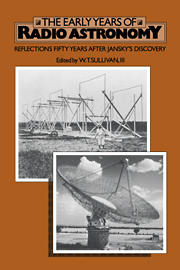Book contents
- Frontmatter
- Contents
- Preface
- THE EARLIEST YEARS
- AUSTRALIA
- ENGLAND
- THE REST OF THE WORLD
- The first steps of Soviet radio astronomy
- Remarks on my work in radio astronomy
- The early years of radio astronomy in France
- Beginnings of solar radio astronomy in Canada
- Development of solar radio astronomy in Japan up until 1960
- BROADER REFLECTIONS
- Biographical notes on contributors
- Name index
- Subject index
Beginnings of solar radio astronomy in Canada
Published online by Cambridge University Press: 05 March 2010
- Frontmatter
- Contents
- Preface
- THE EARLIEST YEARS
- AUSTRALIA
- ENGLAND
- THE REST OF THE WORLD
- The first steps of Soviet radio astronomy
- Remarks on my work in radio astronomy
- The early years of radio astronomy in France
- Beginnings of solar radio astronomy in Canada
- Development of solar radio astronomy in Japan up until 1960
- BROADER REFLECTIONS
- Biographical notes on contributors
- Name index
- Subject index
Summary
Thirty seven years have elapsed since I first thought about undertaking studies in cosmic noise, a large portion in the fifty year life of a new science. I had arrived in Ottawa in the summer of 1942, rather late in the development of the radar programs in progress at the Radio Field Station (RFS) of the National Research Council (NRC). By the fall of 1945 we were being asked to suggest projects needed for the transformation from war to peace. Before coming to the NRC, my colleagues and I had been students at university, so that at this time, when there was some hope of returning to our studies, there were many discussions concerning our future activities. It was in such an environment that I realized that the cosmic static survey of Grote Reber could be extended to microwavelengths by using radar radio receivers of greatly improved sensitivity. As a graduate student, while browsing through journals in a library sometime in 1939, I had learned of Reber's continuation of Karl Jansky's work. At least if I were to return to university, a simple experiment with more sensitive receivers could be quickly made at the RFS in a new region of the electromagnetic spectrum.
The possibility of observing cosmic noise from Sagittarius and determining its intensity by using the thermal noise from the sun as a known source was presented orally to W.J. Henderson, Microwave Section Head, sometime in the late fall of 1945 while he was attending to the vacuum system of the tube laboratory.
- Type
- Chapter
- Information
- The Early Years of Radio AstronomyReflections Fifty Years after Jansky's Discovery, pp. 317 - 334Publisher: Cambridge University PressPrint publication year: 1984
- 5
- Cited by

